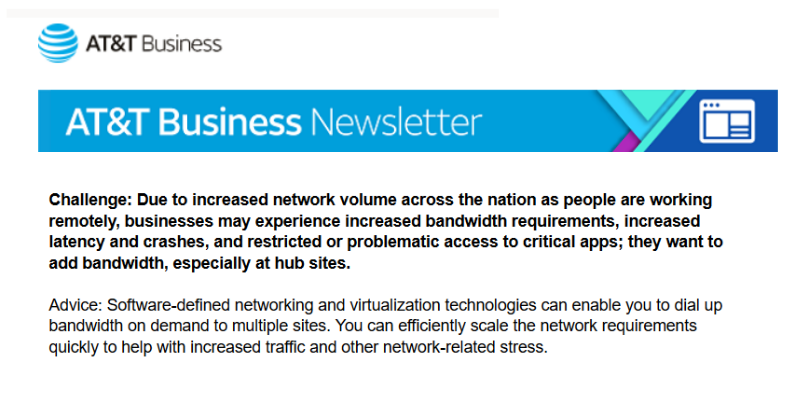Like many Outlook inboxes, mine has been filling up with emails that reference the pandemic. I estimate only about a third have valuable information related to the crisis.
In our efforts not to be tone deaf, it seems we’re not only being tone deaf but also forgetting the number one rule of B2B content marketing: Begin with the buyer.
Yes, we want to be authentic and show our human side. But remember, it’s not about us and never has been. It’s about the buyer, and to assume instant simpatico because of an unanticipated global health crisis is about as inauthentic as you can get.
A better path is to serve buyers by being helpful—that is, by giving them information that is related to their business pain points, not their personal lives. And most importantly, don’t make assumptions about what buyers are experiencing or how they feel about it. This is not good B2B marketing, especially now that data-driven decision-making is the norm.
Dispelling the “Extra Time” Myth
Assumptions about what buyers are experiencing began early on in this crisis. When businesses started shuttering offices and sending people home to work, I received a bunch of emails that went something like this:
“Now that you have more time on your hands, watch our video/read our E-book/reread our E-book … ”
This messaging confused me, because I am one of the 8 million Americans who had already been working at home, and it’s flat-out wrong that working from home frees up extra time. Even if you normally have a long commute, work fills those time gaps quickly, especially in a time of crisis.
Simultaneous to businesses closing, schools and child-care centers closed. This meant people with young children at home (41% of the U.S. population) suddenly had even less time to engage with content, because they were adding daytime teaching and caregiving to their agendas.
Even if someone did have extra time now, would they want to spend it watching a marketing video or reading an E-book while their lives are being upended by social distancing, panic hoarding and maybe crippling fear? Or even worse, illness, death or job losses?
I understand why this mythical storyline emerged. It seemed safe (timely yet innocuous), and many marketing professionals found themselves working from home for the first time, so it was top of mind. The problem is that’s exactly how it sounded—convenient for the sender instead of helpful to the recipient.
Urgency and Relevance Should Guide Messaging
So, what should you say to your market about COVID-19? If you don’t have anything to say that’s urgent or relevant to your buyers, then don’t say anything.
Targeted messaging presented at the right time is a foundational element of B2B marketing engagement—even during a pandemic—and it’s been interesting to watch how closely (or loosely) people adhere to this principle.
Like everyone else, I was receiving a lot of “we’re here for you” emails in the early weeks of the pandemic from company executives. Only a handful had anything valuable to offer besides the B2B equivalent of “thoughts and prayers.” It felt a little icky, like a stranger coming in for a hug because they needed one.
But I was glad to see businesses that could offer concrete help do so right away. Among our clients, SOC Telemed (telehealth) and Poly (virtual conferencing services) immediately put out content about how buyers could genuinely benefit from their services as lockdowns and closures began. The timing was appropriate because there was real buyer urgency around those needs.
About a week ago, I started seeing a second wave of content that focused on transparency in staffing changes, customer service commitments, relevant solutions and content resources. For the most part, these have been full of valuable, actionable information, like a short email about network challenges from AT&T that was forthright about problems their business customers are experiencing:

I thought the setup and timing of this email was spot-on, because these types of purchases—plunking down unbudgeted dollars due to an unexpected need—don’t happen without documentation and a formal risk assessment, and those things take time. Putting this information out too early in the crisis would have missed the window when businesses would be ready to make a change.
I also applaud the timing of this blog post by NSI on VPN challenges, because it talks about employee frustration and engagement in the new normal of working at home. This reality took a bit of time to gel after the initial novelty of workplace changes and is more palpable and precise than a softer “we’re here for you” message.
Stay Focused on B2B Marketing Basics
These are confusing times, so it’s understandable to think that the normal B2B marketing playbook doesn’t apply. But the truth is, it applies more than ever.
Buyers have lots of information coming at them about all aspects of the global crisis. To be truly helpful to them, go back to existing personas and messaging work, and brainstorm how pain points and buyer questions have evolved because of the pandemic and its influence on business strategy and needs. Identify where your area of expertise falls, and answer those questions when you know your buyers will be asking them.
It’s a good thing to want to be authentic and personal in marketing, but stick with B2B basics—even during times of extreme change and emotion.
Your buyers don’t need a virtual hug. They need you to do what you’ve always done best.



